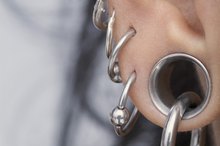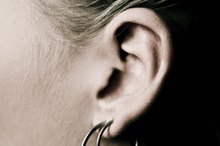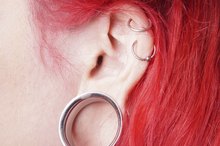How to Clear Up Infected Pierced Ears
The most common cause of infection in body piercings is the transfer of microorganisms from dirty hands to the piercing site, according to the Association of Professional Piercers. Other contaminants that may cause infection come from contact with bodily fluids or unsanitary water, such as when swimming in a lake or river. You’ll know your ear piercing is infected if it secretes thick, green, smelly pus, the site looks red, or it feels swollen and tender. Your earlobe may also feel warm to the touch. You can treat minor infections at home by keeping the infected area clean and using sea salt soaks to draw out irritants.
Use antibacterial or antimicrobial soap to wash your hands to avoid introducing new bacteria to the infected area. Scrub your hands for at least 20 seconds.
What Are the Dangers of Pierced Ears?
Learn More
Dissolve 1 tbsp. of non-iodized sea salt in 8 ounces of warm distilled water.
Soak the infected piercing in the sea salt solution for three to five minutes. If possible, fill a small cup with the solution and submerge the infected lobe. If this is uncomfortable or you have an attached earlobe that makes this difficult, soak sterile gauze or cotton swabs in the solution and apply generous amounts of the solution to the infected area.
How to Prevent Infection in Pierced Ears
Learn More
Rinse with clean, warm water and dry with a clean paper towel. Do not use a hand towel or washcloth because they can harbor germs.
Repeat this method at least once a day in conjunction with your regular cleaning regimen until the infection clears.
Warnings
For a severe infection, you may need to see your doctor for a prescription of oral or topical antibiotics.
Do not remove the earring while the piercing is infected. The wound could close, creating a painful abscess.
Related Articles
Writer Bio
Educated at the Elkhart Area Career Center in Indiana, Amanda Tromley has worked as an illustrator and graphic designer for more than 10 years. Additionally, she writes and designs a blog that provides tips, tutorials, and tools for professional and amateur artists. Tromley began writing professionally in 2007 with articles on a variety of topics appearing in print newsletters and popular websites, including eHow.







